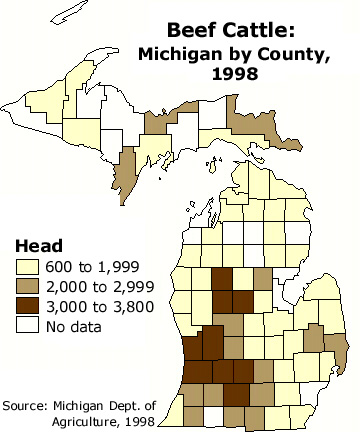BEEF CATTLE
Meat from cattle is called beef. Cattle also produce a variety of by-products used in
industrial, pharmaceutical and household items. Fats and gelatin are used to make soap,
shompoo, cosmetics, desserts, and many industrial products such as photographic film and
light filters.
The pancreas and liver are used for medicines for such diseases as
anemia and hypoglycemia. Hide, hooves and hair are used in products such as sports
equipment, leather goods and paint brushes. The leather from one hide is enough to make
about 18 pairs of shoes. A football, frequently called a "pigskin," is actually
made from cow hide. Ninety-eight percent of evey beef animal is used for meat or other
products.
Ruminant Digestive System
Ruminant animals have a stomach with four compartments. They swallow food in large pieces
into the first stomach compartment ("E" below), bring the food back into the
mouth and chew it again. This is called "chewing the cud." The food is swallowed
again and moves through the four stomach compartments (B, then F, then G). Because
they are ruminant animals, cattle can digest grass, roughage, food by-products and other
materials people can't eat. They convert these otherwise unusable grasses and other
products into nutrients for humans. Camels, deer, sheep and llamas are also ruminant
animals.

Source: Central Michigan University
Note that the map above refers to all cattle in the Great Lakes region, while the map below is specific to BEEF cattle.

The map below is from the 1960's. It shows that beef and livestock production used
to be located farther south in the state, near the Indiana border. With the advent
of shorter-day corn hybrids, more farmers have been able to grow corn farther to the
north. Thus, cattle-raising has also moved with it, and as the map above show, beef
production is now more important to the north of Grand Rapids than it has ever been.

Source: Hill, E.B., Riddell, F.T., and F.F. Elliot. 1930. Types of farming in Michigan. Michigan Agricultural Experiment Station Special Bulletin 206.
This material has been compiled for educational use only, and may not be reproduced without permission. One copy may be printed for personal use. Please contact Randall Schaetzl (soils@msu.edu) for more information or permissions.